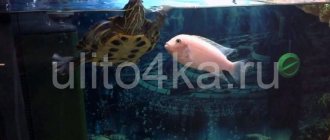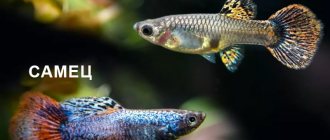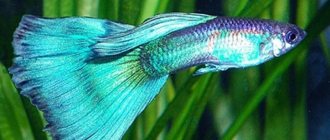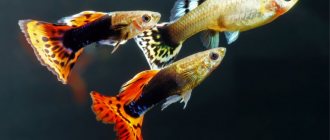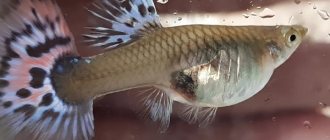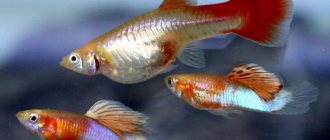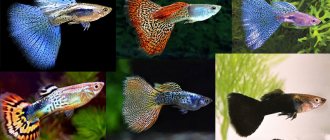Compatibility parameters of guppies with aquarium fish
Guppy is a small viviparous fish, extremely hardy and unpretentious. The length of females is 6 cm, and males are half as long. Finding good neighbors for guppies is not so easy. And the point is not in the capriciousness of these fish, but in the many conditions that applicants for living together with guppies must satisfy.
Why is it necessary to take into account the compatibility of fish and what to look for when choosing neighbors for guppies:
- Habitat. Inhabitants of aquariums need certain conditions of maintenance. These include temperature, acidity and salinity of water, feeding regime. Some feel good in cold water - up to +23°C, others in warm water - above +26°C. Some fish vitally need aeration, others cannot tolerate even the slightest movement of water, some prefer an alkaline environment, others an acidic one. Even soil requirements may vary.
- Character. Fish live long if they are in a favorable environment. The presence of predatory fish causes stress and rapid death in peaceful species. They have to constantly hide, saving their lives, and predators also do not know peace until they get to their victims. Guppies are very small and have no means of defense. All they can do is hide in seaweed and behind rocks from aggressors. They need to choose the calmest and most non-aggressive fish as neighbors.
- Temperament. Slow fish do not feel well next to active neighbors who are constantly scurrying around the aquarium. In addition, overly active fish are prone to aggression; they are capable of biting off the beautiful veil-like tails of their calmer neighbors in a matter of days.
- Price. There are very expensive fish that are not worth risking. If you pay several thousand rubles for one specimen, it’s a shame that due to careless neighbors in the aquarium it dies within a short time.
- Size. The guppies' neighbors should be comparable in size to them. Large fish, even the calmest and non-aggressive ones, can easily swallow guppies. In addition, large fish irritate small fish with their mere presence.
- Plants. A guppy's aquarium must have plants. They saturate the water with oxygen and create a favorable habitat for fish. You cannot keep fish with guppies that cannot live in a planted aquarium.
Male guppies have a luxurious, veiled tail, which is a powerful irritant to tankmates. Movements of the tail immediately attract active fish, which rush at the guppies and pluck their tails.
Danio is a neighbor that requires attention
Most often, zebrafish get along well with guppies.
Aquarists note that guppies and friendly danios are ideal neighbors without infringing on each other’s rights. Danios are just as hardy and calm as they and their platypus friends, guppies. It is better to keep zebrafish in schools (10 individuals at a time), otherwise they will become too fast and races will be unavoidable.
Although it happens that in a large school of zebrafish there are notorious mischievous people who are not averse to chasing their own brothers across the expanses of water. It happens that guppies do not show their best side, biting the tails of peaceful zebrafish, especially the veiled breed, which has something to boast about. In any case, based on the many years of experience of fish farmers, you can safely add a school of zebrafish to a group of frogs without fear for the health and morale of both species.
Types of compatibility
All existing fish have their own requirements for aquarium neighbors. Among the latter you can find fish that are more or less desirable for living together.
When selecting aquarium neighbors, the degree of compatibility is taken into account:
- ideal neighbors - 100% compatibility;
- absolutely not suitable - 100% incompatibility;
- a risky decision is an unpredictable neighborhood that can be either favorable or disastrous.
If in the first two cases there is no doubt, then partial compatibility is ambiguous. How fish of different species behave largely depends on the experience of the aquarist. If the aquarium is large, then fish with dubious compatibility can get along quite well.
Botsia, iris, rasboras
Botia are well compatible with guppies. They are characterized by high resistance to diseases, low maintenance requirements, peaceful behavior and medium-sized body size.
Rainbowfish are in great demand among aquarists because... have a beautiful color. They are good neighbors for poeciliid fish. Rainbowfish and guppies prefer the same habitat conditions and water regime.
Different types of rasboras have different sizes (from 2 to 10 cm in length). Individuals no larger than 5 cm in size will be good neighbors for guppies.
Four rules of compatibility
Even without being very familiar with the habits of different fish, you can avoid troubles in the aquarium. There are four rules that are useful for beginners to know before filling an aquarium with fish.
The main rules for fish living together in an aquarium are prohibitions. In one aquarium you cannot contain:
- predatory fish with non-predatory fish;
- small fish with large ones;
- slow with active.
The fourth law of compatibility states that newcomers should not be placed in an already established company.
Introduction
Guppies are one of the most famous and widespread aquarium fish on the planet. It is difficult to find an aquarist who has never encountered this beautiful viviparous fish in his career. There are real legends about its unpretentiousness, and breeders are still trying (and quite successfully) to get more and more new breeds with the most original pattern or shape of fins.
Such strong popular love and widespread distribution make the issue of guppies cohabiting with other aquarium inhabitants relevant. Let's consider the basic rules of compatibility of the “fish of the millennium”:
Aquarium fish compatibility chart
To make it more convenient to choose your aquarium neighbors, special tables have been compiled. They are based on the above four rules of compatibility, but do not take into account the parameters of water, soil and other living conditions - these should be taken into account by aquarists after selecting suitable candidates.
Table: favorable and unfavorable neighbors for guppies:
| Name of aquarium fish | Compatibility |
| Akary | No |
| Ampoules | Yes |
| Apistograms | Yes |
| African cichlids | No |
| Acantophthalmus Kühl | Yes |
| Barbs | No |
| Botsiya | risk |
| Guppy | Yes |
| Gourami | risk |
| Danio | Yes |
| Discus | risk |
| Goldfish | No |
| Corridors | risk |
| Red parrot | No |
| Lamp eyes | Yes |
| Labeo | risk |
| Lyalius | Yes |
| Minor | risk |
| sword bearer | risk |
| Neons | Yes |
| Ornathus | Yes |
| Cockerels | risk |
| Pecilia | Yes |
| Pristells | Yes |
| Rainbows | Yes |
| Rasbory | Yes |
| Angelfish | risk |
| Ternetia | Yes |
| Tetras | Yes |
Reproduction
Characins are easy to breed at home. It is important to provide the necessary care and pay special attention to the fry.
Sex differences
Determine the sex by the shape of the fins. The dorsal fin of the male is pointed and narrowed; closer to the tail, the anal fin narrows. Males are slimmer than females and slightly smaller.
Spawning
Puberty occurs at 8 months of age. Individuals older than 2 years cannot spawn. Ternetias reproduce in a previously prepared spawning tank:
- prepare an aquarium from 15 l;
- Place mosses and bushes of plants at the bottom;
- set the temperature to 28 degrees;
- acidity should be 6-6.5;
- provide good aeration.
4-5 days before spawning, feed the breeders with protein food. Place the future parents in the spawning tank. During the spawning process, the male begins to chase the female around the aquarium.
The female lays up to 1000 eggs. To prevent the parents from eating the eggs, remove the spawners from the spawning area. Keep the temperature high and treat the water with methylene blue. The eggs are incubated for 24 hours, and the emerging larvae swim freely after 72 hours. At this time, start feeding the fry; their diet should consist of:
- Artemia nauplii;
- live dust;
- ground food for adult fish;
- ciliates.
Compatible fish species
These fish are considered the best neighbors for miniature guppies. They can get along well in the same aquarium without creating problems for each other.
Other breeds of guppies
Guppies are ideal material for breeders. These viviparous fish reproduce quickly and easily, producing viable offspring. There are a huge number of varieties of guppies, differing in appearance.
Regardless of the color and shape of the fins, guppies of different species get along well with each other. In one aquarium you can safely keep any number of species of guppies without any risks - the fish will live together and will not create problems for each other.
The only thing you should pay attention to when keeping different types of guppies in the same aquarium is loss of breed. The fish will begin to interbreed and the purity of the breeds living side by side with each other will be lost.
Danio
Nimble fish with longitudinal stripes are the most successful neighbors for guppies. Because of their striped sides, zebrafish were given a second name: zebra fish. They are distinguished by a very peaceful disposition, and, like guppies, are undemanding to living conditions.
Danios like to be in the upper layers of the aquarium, and guppies like to be in the middle. In this way, the fish peacefully share space. Both types of fish happily eat the same type of dry food, which is especially convenient for feeding.
Pecilia
A luxurious viviparous fish that can decorate any aquarium. Platies can have a wide variety of colors - golden, red, coral, variegated and others. Like guppies, platies are one of the most popular aquarium fish.
When living in the same aquarium, conflicts between guppies and platies do not arise. Both species get along well and do not tend to share food or territory. The only dangerous point is the risk of eating guppy fry. But the problem is easily solved - young animals are raised in nurseries.
Cardinals
This is a peace-loving and active fish, which is easily recognized by its longitudinal stripe running across the entire body. Cardinals have spread throughout the world from China and are very popular among aquarists.
Cardinals can be placed in the same aquarium with all non-aggressive fish, including guppies. They do not require any special conditions and do not show aggression towards their neighbors. The fish owes its name to its bright color, reminiscent of the color of a cardinal’s robe.
Rasbory
These freshwater tropical fish are ideal companions for guppies. They lead a gregarious lifestyle and are undemanding to living conditions. They are distinguished by variety and originality of colors.
Rasboras are native to Southeast Asia, they are very beautiful and resemble guppies not only in size, but also in temperament. There is virtually no risk of conflict between them.
Tetras
South American tetra fish look harmonious in the same aquarium with guppies and bring some excitement into his life. They are mobile, lead a gregarious lifestyle and do not require special conditions of detention.
Agile and nimble tetras have beautiful and bright colors, they are completely non-conflicting and are able to maintain good neighborly relations with most peace-loving fish.
Solitary tetras are aggressive in the aquarium, so it is recommended to keep these fish in small schools.
Corridors
These mustachioed freshwater fish have a very interesting appearance and easily become a decoration for any aquarium. Their second name is armored catfish, which they received due to the presence of two bony plates running along the body.
Corydoras are among the TOP 10 most popular aquarium fish. They are distinguished by their peaceful nature and unusual behavior. Despite their size - catfish are twice as large as guppies, they do not pose a threat to viviparous fish.
Corydoras fish are excellent cleaners. Moving along the bottom, they carefully clean the aquarium from any remaining food that falls from above.
Neons
This small schooling fish is popular due to its special shine. “Glowing” fish rarely grow more than 5 cm; they are peaceful and prefer to live in the lower layers of the aquarium.
Neons and guppies, having similar sizes, behavior and diet, get along well in the same aquarium. The former are completely safe and can themselves become prey for any large fish; guppies and aquarium catfish are their best neighbors.
Neons never spoil aquarium vegetation. Unlike other fish, they do not tear it out by the roots, but carefully bite it off.
Botsiya
These fish from the loach family lead a schooling and crepuscular lifestyle. If you create a good habitat for them, they are quite peaceful and practically do not conflict with their neighbors in the aquarium.
They can live with guppies in the same tank if it is large enough. Both types of fish are unpretentious and have a calm disposition. Conditional compatibility is associated with the risk of fin biting. If the aquarium is crowded and the bots are too large, the guppy's veiled tails are subject to constant attacks.
Lampoglazik
Alone, lampeyes are not particularly attractive. But in a flock they look very beautiful. These small, luminous fish, reaching a length of 3 cm, moving in groups, create a spectacular aquarium picture.
Lampeyes have a harmless disposition and get along well with peace-loving guppies. These small, snake-like fish live in the bottom layers of the aquarium.
Rainbows
Rainbowfish are colorful fish, the color of which is dominated by a combination of several colors, giving them an iridescent glow. These oceanic fish have a second name - “children of the rising sun”; they are quite peaceful and get along well with guppies.
Rainbowfish and guppies have a lot in common - they are hardy and unpretentious, have good immunity, have a calm disposition and are small in size. They also have the same requirements for water parameters.
Acantophthalmus Kühl
The little loach is not only very impressive, but also has an excellent character. All peaceful inhabitants of aquariums, including guppies, can get along with this harmless, snake-like fish.
Acantophthalmus Kühl looks like a snake or eel; it constantly moves in the bottom layers of the aquarium. This agile, striped fish tirelessly searches for food in the ground. The loach does not show any aggression towards the guppy.
Apistograms
Apistogramma are small cichlid fish with luxurious fins, a bushy tail and multi-colored colors. They are extremely impressive and resemble fairy-tale “goldfish”. Their color can combine a variety of colors - blue, red, yellow, orange and many others.
The handsome Apistogramma are very diverse, among them there are both large and small varieties. They have a calm disposition and get along well with guppies, neons and other small aquarium fish.
Ornathus
These are tiny fish that attract aquarists not only for their beauty, but also for their good health. Ornathus belongs to the characin family, native to the Amazon; they are unpretentious and easily adapt to a wide variety of conditions.
Ornathus have a peaceful disposition, so they become good neighbors for all calm and non-aggressive fish - guppies, catfish, neons, swordtails and others.
Pristella
A small elegant fish comes from South American reservoirs, belongs to the characin family, and is the only representative of its genus. This fish loves plants and never harms them.
Pristellas are unpretentious to water parameters, peaceful, and have a calm disposition. But they are very demanding about the purity of water. This schooling fish gets along well with neighbors similar to it in temperament and size.
Pristella, due to its original coloring, is often called “goldfinch” or “tetra-X-ray” among aquarists and fish dealers.
Cockerels
Like most representatives of the labyrinthine suborder, cockerels have luxurious, fan-shaped fins, which often arouse the interest of other inhabitants, and they mercilessly tear them off. Such troubles will not happen if you place the cockerels with small, non-pugnacious fish - shellfish, zebrafish, gupeshkas, pleco catfish, Rasbor fish, etc.
The cockerel himself is no slouch, and has a very cocky disposition; it’s not for nothing that these fish are called fighting fish. To prevent the aquarium from becoming an arena for gladiators, you should not add them to barbs, angelfish, cichlids, discus fish, loaches, goldfish, gouramis, koi carps, astronotus, and labeo. Also, do not stock the tank with shrimp.
The situation will turn out to be terrible if two males of a given breed are placed in one dwelling - they will sort things out day and night. If in the natural environment the injured fish has the opportunity to retreat, then in a limited space there is only one way out - to fight until one of the fighters dies. Females can also suffer - both from each other and from gentlemen, who are quite angry outside the spawning period.
Relatively compatible species
Such fish can coexist with guppies in the same aquarium, but under certain conditions. It is important to take into account the specific behavior and age of each fish species. The proximity of conditionally compatible fish requires the attention of the aquarist; it is not recommended for beginners to keep similar fish together.
Barbs
These are cheerful and beautiful fish, undemanding and peaceful, and are considered conditionally compatible, as they can bite guppies and other small fish on the fins. They are very fussy and stop “running around” only after the lights in the aquarium are turned off.
In nature, barbs are omnivores, eating worms, larvae, insects, and in aquariums, like guppies, they readily eat dry food. These fish have interesting colors that liven up any aquarium.
Gourami
A beautiful and peaceful fish, there are conflicting opinions about its compatibility with guppies. Gourami have an easy-going nature, so they have every chance of getting along with guppies. On the other hand, they are much larger, so they can irritate their miniature neighbors.
Guppies and gourami can live in the same aquarium, but neither will have a peaceful life. Gourami will not eat small fish, but they will certainly bite their tails.
Angelfish
This large fish from the cichlid family has long fins that make it look like a large butterfly. Angelfish are quite large and love to feast on the small inhabitants of the aquarium. They happily eat fry, shrimp and other aquarium small things.
Guppies do not live very harmoniously with angelfish, since large cichlids often go on the attack. If the angelfish does not eat the small livebearer, then the tail will probably break off. Cohabitation between guppies and angelfish is acceptable, but needs to be controlled.
Plecostomus
The chain catfish or plecostomus has ancient origins and is nocturnal. This original fish reaches a length of 50 cm, has a suction cup mouth and feeds mainly on plant foods.
In plecostomus, temperament changes throughout life. At first they are peaceful, then they actively defend their territory. Catfish do not show aggression towards guppies, but a large neighbor may accidentally swallow a small fish.
Ancistrus
Ancistrus are much smaller than plecostomus and are the most popular among aquarium catfish. They have spotted coloring and luxurious whiskers. These catfish are not only beautiful, but also excellent cleaners; they are often called “aquarium nurses.”
Ancistrus catfish are unpretentious, have interesting behavior and are considered conditionally compatible with all small fish, including guppies. The reason for being assigned to the risky group is unintentional eating. Catfish can simply accidentally swallow small fish.
sword bearer
A distinctive feature of these viviparous fish is the elongated ray of the caudal fin, from which the swordtail got its name. They are unpretentious, bright, easy to reproduce and very popular.
Swordtails can often be found together with guppies in the same aquarium, but they, like many other fish, are very attracted to veil-shaped tails. To minimize the risk of guppies biting their tails, these fish should be given the largest aquarium possible.
Endler's guppy
It is endemic to the Venezuelan lakes and a close relative of common guppies. A very beautiful motley fish, which has many varieties bred by breeders.
Endemics get along well with ordinary guppies, but due to crossing, offspring are obtained that do not have the characteristics of their parents and are inferior to them in beauty.
Labeo
Benthic labeo fish feed on algae and have a shark-shaped body. They are extremely mobile and have bright colors - the body and tail are painted in contrasting colors.
Labeos are good cleaners and are often chosen instead of catfish. Young individuals are quite peaceful, but with age, sharp territoriality begins to appear - adult fish can show aggression towards neighbors.
Minor
These schooling fish from the characin family are distinguished by their bright red color and black dorsal fin. They are spectacular and unpretentious, so they are recommended for beginning aquarists.
Guppies and minors have approximately the same aquarium requirements and are similar in size. They get along well, but attacks on the guppy's veil-shaped tails are possible. The minors, having dispersed, can pluck them to the ground. To avoid this, minors are kept in schools, and shelters are provided for guppies.
Lyalius
The beauty of these fish can outshine the brightest inhabitants of the aquarium. Having a bright appearance, lalius are distinguished by a peaceful, meek and timid disposition, which is why they get the worst of the more active fish.
Lalius is one of the few species that, unlike most fish, suffers from the activity of guppies. The latter, afraid of large fish, gladly take it out on the defenseless lalius, chasing them throughout the aquarium.
Cockerels
These cocky fish with luxurious tails look like fairy-tale creatures. They have not only a bright appearance, but also a fighting character. Bettas can attack guppies, but if the aquarium is spacious, cohabitation of these fish is possible.
Although guppies and bettas are considered conditionally compatible, they are not suitable for each other in terms of water parameters, and this should also be taken into account by aquarists who want to place these fish together - some of them will end up in worse conditions.
Ternetia
Small South American fish have a laconic dark silver color and an enlarged anal fin that looks like a skirt. Ternetias are relatives of the piranha, but have a rather peaceful disposition.
Thorns are schooling fish and can show aggression towards guppies if they are placed in a cramped aquarium. If the fish have enough living space, problems between them, as a rule, do not arise.
Bottom line
Guppy is a very small fish, so you should be careful when introducing other fish species into it. You must first find out which fish get along with guppies in the aquarium. You should study the behavior and lifestyle of the proposed neighbors before moving them in so that the life of the little fish is comfortable.
Experienced aquarists recommend creating a species aquarium. This is facilitated by the presence of different colors of these fish. The best neighbors in this case are emerald guppies and Endler's guppies.
It’s better to choose fish of different colors that will look impressive in your home aquarium.
Who definitely wouldn't be a good neighbor?
Fish that pose a physical threat to guppies are absolutely not suitable for them as neighbors. This category includes predatory, aggressive and overly large species that can intentionally or inadvertently swallow small fish.
South American cichlids
This large family includes agile fish with an interesting appearance and bright colors that catch the eye. Cichlids can become the main decoration of any aquarium.
American cichlids treat guppies as live food, so they cannot live together. Large fish will swallow a small fish without a second thought. The nature of different types of cichlids may differ, but all of them are contraindicated in proximity to guppies.
African cichlids
African cichlids have an elongated and dense body, they have well-developed fins and multi-colored colors. They are unpretentious, but require maintaining a certain water hardness.
These fish are very diverse, but they are all bright, lively and even aggressive. They are unfriendly with any neighbors, and they will simply swallow peace-loving guppies without any hesitation.
Discus
One of the most enviable inhabitants of the aquarium. The fish is very decorative - it has a round shape with an original color and a small mouth, its eyes are usually bright red. They are not suitable for companionship with guppies due to high requirements for water quality.
Beautiful discus fish can only live in high-quality water, so they rarely manage to get along with anyone. Neither guppies, nor barbs, nor goldfish are suitable for them. Discus fish are designed for single-species aquariums.
Goldfish
These freshwater ornamental fish are not at all suitable for cohabitation with guppies in the same aquarium. Species have different comfortable water temperatures, and adult goldfish can be many times larger than guppies.
A golden fish, completely harmless in appearance, can easily swallow an unwary small fish. In addition, this species is incompatible with most aquarium plants, which guppies cannot do without.
Fish compatibility is the most important parameter, without which successful breeding and keeping of fish in aquariums is impossible. Before introducing a new fish into your aquarium, be sure to look at the compatibility table and familiarize yourself with the conditions of its keeping.
Barbs, gourami, lalius
Barbs are conditionally compatible with guppies. A large aquarium is required for their cohabitation. Barbs can bite the fins and tails of small fish, so it is better to keep them separately. Barbs are easy to care for and unpretentious.
In order for the fish to live long and not experience constant stress, it is recommended to keep guppies together with peace-loving gouramis, which include:
- chocolate;
- ocelathus;
- dwarf gouramis.
A large aquarium volume is a prerequisite for keeping these two species together. It is necessary to pay special attention to water parameters so that they are optimal for both varieties. Gourami are demanding in terms of living conditions, so all necessary standards must be observed to provide them with a comfortable environment.
Lyalius are characterized by timid behavior. It is necessary to create many shelters for them, and only after that add them to the aquarium. They will try to hide from other fish until they get used to living together in the same territory. These are unpretentious fish.
Feeding
Ternetias like to feed in the upper layers of water, so the food must be appropriate.
Thorns are quite picky about food. However, in order for them to maintain a beautiful appearance, it is necessary to ensure the presence of live food in the diet. Without it, the color of the fish fades. Pets eat food from the surface of the water, and therefore it is necessary to choose types that will float on top for a long time without settling to the bottom. They will also pick up food from the bottom, but this is not very convenient for thorns.
Feeding is carried out in the morning and evening. Feed portions should be such that they are eaten within 10 minutes. All excess is removed from the reservoir immediately.
